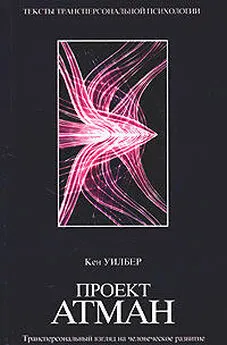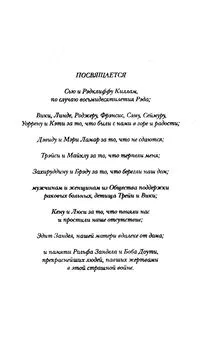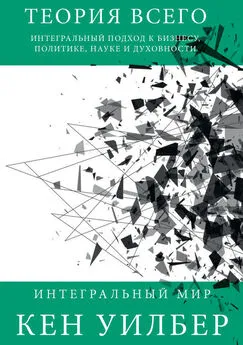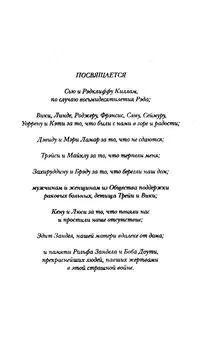Кен Уилбер - Проект Атман
- Название:Проект Атман
- Автор:
- Жанр:
- Издательство:Издательство АСТ
- Год:2004
- Город:Москва
- ISBN:5–17–021069–8
- Рейтинг:
- Избранное:Добавить в избранное
-
Отзывы:
-
Ваша оценка:
Кен Уилбер - Проект Атман краткое содержание
В книге одного из ведущих теоретиков трансперсональной психологии сопоставляются взгляды наиболее известных психологических школ и духовных традиций на эволюцию человека. Делается попытка аналитически разрешить проблему достижения всеединства — или проекта Атмана — как называет ее автор.
Издатели благодарят Алексея Купцова, чья финансовая помощь и дружеская поддержка сделали возможной публикацию этой книги. Перевод с английского под редакцией Александра Киселева Научный редактор кандидат философских наук Владимир Майков Серийное оформление Павла Иващука
© Ken Wilber, 1980
© Институт трансперсональной психологии, 2004
© Издательство К. Кравчука, 2004
© Оформление ООО «Издательство ACT», 2004
Тираж 3000 экз.
Проект Атман - читать онлайн бесплатно полную версию (весь текст целиком)
Интервал:
Закладка:







БИБЛИОГРАФИЯ
[1]. Allport, G. W. Personality: a psychological interpretation. New York: Holt, Rinehart, Winston, 1937.
[2]. Allport, G. W. Pattern and growth in personality. New York: Holt, Rinehart, Winston, 1961.
[3]. Anderson, R. «A holographic model of transpersonal consciousness». J. Transpersonal Psychol, vol 9, no. 2, 1977.
[4]. Angyal, A. Neurosis and treatment: a holistic theory. New York: Wiley, 1965.
[5]. Aquinas, T. Summa theologiae. 2 vols. Garden City: Doubleday, 1969.
[6]. Arieti, S. Interpretation of schizophrenia. New York: Brunner, 1955.
[7]. Arieti, S. The intra‑psychic self. New York: BasicBook, 1967.
[8]. Arieti, S. Creativity: the magic synthesis. New York, BasicBook, 1976.
[9]. Arlow, J. A., andBrenner, С Psychoanalytic concepts and the structural theory. New York, International Universities Press, 1964.
[10]. Assagioli, R. Psychosynthesis. New York: Viking, 1965.
[11]. Aurobindo, The life divine. Pondicherry: Centenary Library, XVIII, XIX.
[12]. Aurobindo, The synthesis of yoga. Pondicherry: Centenary Library, XX, XXI.
[13]. Aurobindo, The essential Aurobindo. McDermott, R. (ed.) New York: Schocken, 1973.
[14]. Ausubel, D. Ego development and the personality disorders. New York: Grune and Stratton, 1952.
[15]. Avalon, A. The serpent power. New York: Dover, 1974.
[16]. Baba Ram Dass. Be here now. San Cristobal: Lama Foundation, 1971.
[17]. Bachofen, J. Das mutterecht. Basel, 1948. 2 vols.
[18]. Bak, A. «The phallic woman: the ubiquitous fantasy in perversions». Psychoanalitic Study of the Child, 1968.
[19]. Bakan, D. The duality of human existence. Chicago: Rand McNally, 1966.
[20]. Baldwin, J. M. Thought and things. New York: Arno, 1975.
[21]. Bandura, A. Social learning theory. Englewood Cliffs: Prentice Hall, 1977.
[22]. Barfield, O. The rediscovery of meaning. Adventures of the Mind, Sat. Evening Post, vol. 1. New York: Knopf, 1961.
[23]. Bateson, G. Steps to an ecology of mind. New York: Ballantine, 1972.
[24]. Battista, J. The holographic model, holistic paradigm, information theory and consciousness. Re‑Vision, vol. 1, no. 3/4, 1978.
[25]. Becker, E. The denial of death. New York: Free Press, 1973.
[26]. Becker, E. Escape from evil. New York: Free Press, 1975.
[27]. Benoit, H. The supreme doctrine. New York: Viking, 1955.
[28]. Berdyaev, N. The destiny of man. New York: Harper, 1960.
[29]. Berger, R. and Luckmann, T. The social construction of reality. New York: Doubleday, 1972.
[30]. Bergson, H. Introduction to metaphysics. New York, 1949.
[31]. Bergson, H. Time and free will. New York: Harper, 1960.
[32].B erne, E. Games people play. New York: Grove, 1967.
[33]. Berne, E. What do you say after you say hello? New York: Bantam, 1974.
[34]. Bertalanffy, L. von. The mind‑body problem: a new view. Psychosomatic Medicine, vol. 26, no. 1, 1964.
[35]. Bharati, A. The tantric tradition. Garden City: Anchor, 1965.
[36]. Binswanger, L. Being‑in‑the‑word. New York: BasicBooks, 1963.
[37]. Blakney, R. B. (trans). Meister Eckhart. New York: Harper, 1941.
[38]. Blanck, G. andBlanck, R. Ego Psychology: theory and practice. New York: Columbia Univ. Press, 1974.
[39]. Blanco, M. The unconscious as infinite sets. London: Duckworth, 1975.
[40]. Blavatsky, H. P. The secret doctrine. London: Theosophical Publishing House, 1966.
[41]. Blofeld, J. Zen teaching of Huang Po. New York: Grove, 1958.
[42]. Blofeld, J. Zen teaching of Hui Hai. London: Rider, 1969.
[43]. Blofeld, J. The tantric mysticism of Tibet. New York: Dutton, 1970.
[44]. Bloom, С. М. Language development. Cambridge: M. I.Т., 1970.
[45]. Blos, P. The genealogy of the ego ideal. Psychoanalytic Study of the Child, vol. 29, 1974.
[46]. Blum, G. Psychoanalytic theories of personality. New York: McGraw‑Hill, 1953.
[47]. Blyth, R. H. Zen and zen classics, vols. 1–5. Tokyo: Hokuseido, 1960.
[48]. Boehme, J. Six theosophic points. Ann Arbor: Univ. of Michigan, 1970.
[49]. Boisen, A. The exploration of the inner world. New York: Harper, 1962.
[50]. Boss, M. Psychoanalysis and daseinanalysis. New York: BasicBooks, 1963.
[51]. Bower, T. Development in infancy. San Francisco: Freeman, 1974.
[52]. Broad, C. D. The mind and its place in nature. New Jersey: Littlefield, Adams, 1960.
[53]. Broughton, J. The development of natural epistemology in adolescence and early adulthood. Unpublished doctoral dissertation, Harvard, 1975.
[54].B rown, D. «A model for the levels of concentrative meditation. Int. J. Clin. Exp. Hypnosis, vol. 25, 1977.
[55].B rown, G. The farther reaches of Gestalt therapy. Synthesis 1. [56].Brown, G. S. Laws of form. New York: Julian, 1972.
[57]. Brown, N. О. Life against death. Middletown: Wesleyan, 1959.
[58]. Brown, N. О. Love’’sbody. New York: Vintage, 1966.
[59]. Bubba Free John. The paradox of instruction. San Francisco: Dawn Horse, 1977.
[60]. Bubba Free John. The enlightenment of the wholebody. Middletown: Dawn Horse, 1978.
[61]. Buber, M. I and thou. New York: Scribners, 1958.
[62]. Bucke, R. Cosmic consciousness. New York: Dutton, 1923.
[63]. Buddhagosa. The path of purity. Pail Text Society, 1923.
[64]. Bugental, J. The search for authenticity. New York: Holt, Rinehart, Winston, 1965.
[65].B urke, K. «The rhetoric of Hitler’’s “battle.”» The philosophy of literary form. New York: Vimtage, 19.
[66]. Campbell, J. The masks of God, vols. 1–4. New York: Viking, 1959, 1962, 1964, 1968.
[67]. Canetti, E. Of fear and freedom. New York: Farrar Strauses, 1950.
[68]. Capra, F. The tao of physics. Berkeley, Shambhala, 1975.
[69]. Cassirer, E. The philosophy of symbolic forms. New Haven: Yale, 1953–1957. 3 vols.
[70]. Castaneda, C. Journey to Ixtlan. New York: Simon and Schuster, 1972.
[71]. Chang, G. C. C. Hundred thousand songs of Milarepa. New York: Harper, 1970.
[72]. Chang, G. C. C. Practice of zen. New York: Harper, 1970.
[73] . Chang, G. C. C. TheBuddhist teaching of totality. Pennsylvania: Univ. of Pen., 1971.
[74]. Chang, G. C. C. Teaching of Tibetan yoga. New Jersey: Citadel, 1974.
[75]. Chapman, J. The early symptoms of schizophrenia. British Journal of Psychiatry, vol. 112, 1966.
[76]. Chaudhuri, H. Philosophy of meditation. New York: Philosophical Library, 1965.
[77]. Chile, С Man makes himself. New York: Mentor, 1957.
[78]. Chomsky, N. Syntactic structures. The Hague: Mouton, 1957.
[79]. Chomsky, N. Language and mind. New York: Harcourt, 1972.
[80]. Conze, E. Buddhist meditation. New York: Harper, 1956.
[81]. Conze, E. Buddhist wisdombooks. London: Allen and Unwin, 1970.
[82]. Cooley, C. H. Human nature and the social order. New York: Scribners, 1902.
[83]. Coomaraswamy, A. K. Hinduism andBuddhism. New York: Philosophical Library, 1943.
[84]. Coomaraswamy, A. K. Recollection, Indian and Platonic. Supplement to JAOS, no. 3, 1944.
[85]. Coomaraswamy, A. K. Time and eternity. Ascna: Artibus Asial, 1947.
[86]. Coomaraswamy, A. K. The dance of Shiva. New York: Noonday, 1957.
[87]. Cooper, D. Psychiatry and anti‑psychiatry. New York: Ballantine, 1971.
[88]. Corsini, R. Current personality theories. Itasca: Peacock, 1977.
[89]. Dasgupta, S. B. An introduction to tantricBuddhism. Berkeley: Shambhala, 1974.
[90]. Davidson, J. The physiology of meditation and mystical consciousness. PerspectiveBiology Medicine, Spring, 1976.
[91]. Dean, S. (ed.) Psychiatry and mysticism. Chicago: Nelson Hall, 1975.
[92]. Deikman, A. De‑automatization and the mystic experience. Psychiatry, vol. 29, 1966.
[93]. Desoille, R. The waking dream in psychoterapy. Paris: Presses Universitaires de France, 1945.
[94]. Deutsche, E. Advaita vedanta. Honolulu: East‑West Center, 1969.
[95]. Dewey, J. andBently, A. F. Knowing and the known. Boston: Beacon, 1949.
[96]. Dewey, J. and Tufts, J. Ethics. New York: Holt, Rinehart, Winston, 1908.
[97]. DiLeo, J. Child development, New York: Brunner/Mazel, 1977.
[98]. Duncan, H. Symbols in society. New York: Oxford Univ., 1968.
[99]. Edgerton, F. (trans). TheBhagavad Gita. New York: Harper, 1964.
[100]. Edinger, E. F. Ego and archetype. Baltimore: Penguin, 1972.
[101]. Ehrmann, J. (ed.) Structuralism. New York: Anchor, 1970.
[102]. Eisendrath, C. The unifying moment. Cambridge: Harvard, 1971.
[103]. Eliade, M. The myth of eternal return. New York: Pantheon, 1954.
[104]. Eliade, M. The sacred and the profane. New York: Harvest, 1959.
[105]. Eliade, M. Shamanism. New York: Pantheon, 1964.
[106]. Eliade, M. Images and symbols. New York: Sheed and Ward, 1969.
[107]. Eliot, C. Hinduism andBuddhism, vols. 1–3. New York: Barnes and Noble, 1968.
[108]. Erikson, E. Childhood and society. New York: Norton, 1963.
[109]. Erikson, E. Insight and responsibility. New York: Norton, 1964.
[110]. Evans‑Wentz, W. The Tibetanbook of the Dead. London: Oxford Univ., 1968.
[111]. Evans‑Wentz, W. The Tibetanbook of the great liberation. London: Oxford Univ., 1968.
[112]. Evans‑Wentz, W. Tibetan yoga and secret doctrines. London: Oxford Univ., 1971.
[113]. Fadiman, J., and Frager, I. (ed.) Personality and personal growth. New York: Harper, 1976.
[114]. Fadiman, J., and Kewman, D. (ed.) Exploring madness. Calif.:Brooks/Cole, 1973.
[115]. Fagan, J., and Sheperd, I. (ed.) Gestalt therapy. New York: Harper, 1970.
[116]. Fairbairn, W. Psychoanalytic studies of the personality. London: Tavistock, 1952.
Читать дальшеИнтервал:
Закладка:










